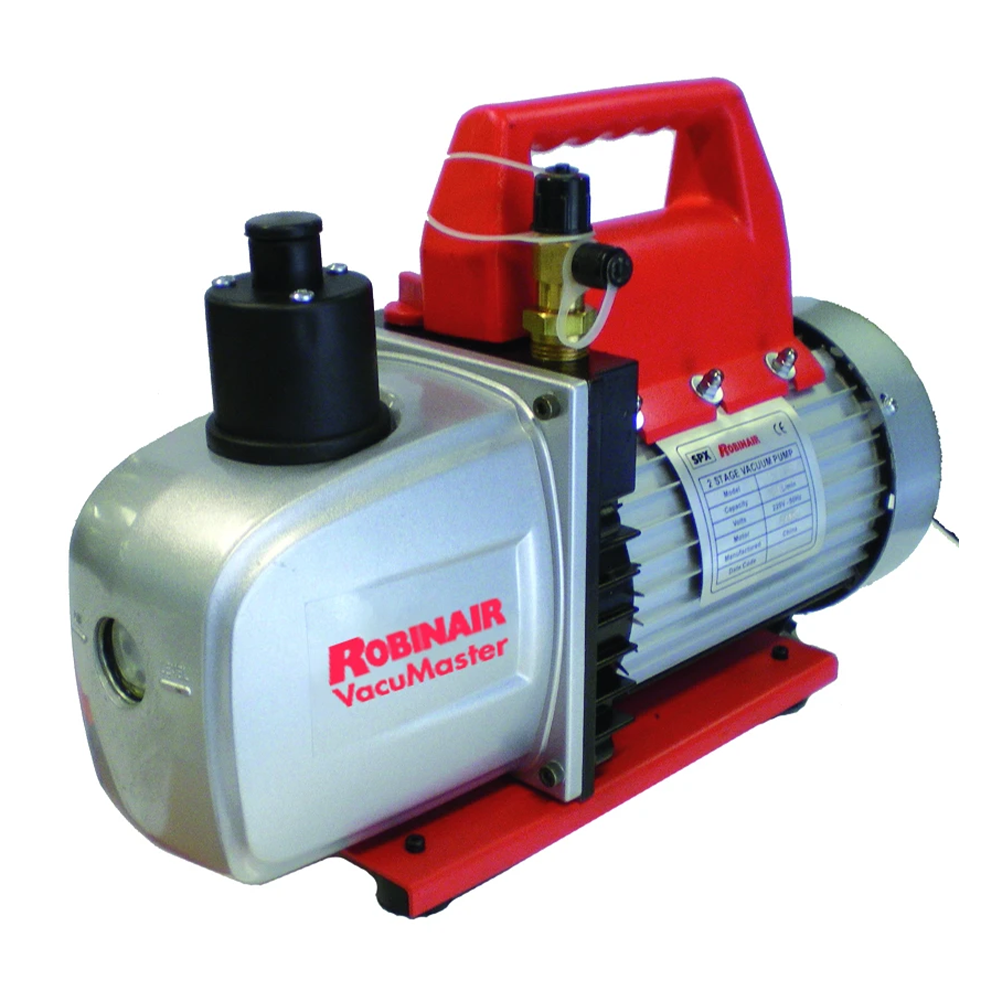Know more about one of HVAC's most important tools: HVAC Vacuum Pump!
After refrigerant recovery and cooling system repair, the HVAC vacuum pump removes gas, vapours, and other impurities from refrigeration systems. Before recharging with refrigerant, a deep and full vacuum is essential to guarantee the Air Conditioning system is clear of pollutants.
Our heavy-duty HVAC pumps feature a design to generate a deep vacuum and pump down swiftly. It reaches 40 microns in hours rather than days or weeks as a light-duty pump might.
Choosing the Right HVAC Vacuum Pump

When choosing a vacuum pump for refrigeration systems, there are various things to consider in addition to vacuum performance and evacuation time. Here are a few characteristics of great HVAC pumps to think about while making your decision.
- Air Flow: The airflow rating of an AC vacuum pump is the most important item to look for before purchasing one. It indicates how much air is transported in a minute and is expressed as 3 CFM or 5 CFM, with a greater cubic feet per minute value indicating better performance.
- Pump Power: You can also look at the pump power rating to understand how well it performs when used with a vacuum pump. It primarily consists of 14 HP and 13 HP vacuum pump variants, providing better performance to the user.
- Stages: Some vacuum pumps are single-stage, while others are two-stage. Even though they perform the same job, a two-stage vacuum pump provides superior cleaning results due to its design and operation.
- Gas Ballast: Capacity to Control High Water Vapors
- Large Oil Reservoir: Dilutes toxins to avoid potential oil changes during a job.
- Size and Performance of Pumps: Meet the tonnage requirements of cold storage, commercial and industrial chillers, rooftop HVAC, RTUs, and absorption chillers.
Vacuum Pump for Air Conditioning
When the air conditioning system is in action, a vacuum pump removes undesired air and water vapour from the system. When an air conditioner needs fixing, the first step is to remove the refrigerant and save it for later use.
After you've completed the recovery process, you can move on to the diagnostic and repair work. The next stage is to inspect and confirm that the system is leak-free. Otherwise, it will need corrective action.
The vacuum pump will then remove air and moisture from the refrigerant system during the evacuation phase. After that, the charging procedure can begin before the system goes through its paces.

The Importance of Evacuation
Just the refrigerant and oil must circulate in a refrigerant system. Air may enter during maintenance or after several years of operation. The nitrogen, oxygen, and moisture in the air entering the system come from the atmosphere. These undesirable components will result in:
- A rise in head pressure causes higher discharge temperatures and compression ratios. It diminishes the system's efficiency.
- Acids are formed in the refrigerant, which causes a chemical reaction that results in electroplating and motor insulation degradation. When the compressor motor's insulation fails, a short circuit occurs, causing damage to the compressor. The compressor is among the most expensive pieces of equipment in the system. Acids also cause metal items to corrode over time.
- Oil, acid, and moisture in the system combine to create sludge. Over time, it will cause the filter drier, strainers, and expansion device to operate improperly.
Operation of an Air Conditioning HVAC Vacuum Pump
You must establish a state of near-vacuum to eliminate all undesired moisture and chemicals from the refrigerant system, with the pressure in the system forced to fall below atmospheric pressure. The absolute value of atmospheric pressure at sea level is 29.92 in. Hg (14.696 psi), 759.999 mm Hg (759,999 microns), or 759.999 mm Hg (759,999 microns).
The vacuum pump in a typical system is required to achieve a vacuum of 300 to 500 microns. It requires an electronic vacuum gauge to gauge the vacuum level in the system. Examine the vacuum pump's specifications to ensure that it can achieve the vacuum level recommended by the equipment's manufacturers.
Rotary compressors are employed in the pumps, and the 2-stage rotary vacuum pumps are the best at producing the lowest vacuums. They are, nevertheless, more expensive, but their ability to properly remove moisture is one of the prime causes why many technicians choose to acquire this type.
As the system achieves a low vacuum state, the moisture begins to boil and turn into vapour, allowing it to be easily removed from the system.
When running the air conditioning vacuum pump, use the correct oil. Only use the specified oil to allow the pump to reach the desired vacuum level.
When choosing an air conditioning vacuum pump, keep the following in mind.
- Before the operation, use a sight glass to check the oil level.
- In a power outage, an anti-suck-back device prevents oil from the pump from seeping into the refrigerant system. The oil used in the refrigerant is not the same as that used in the pump.
- Rating in cubic feet per minute (CFM). The quicker the evacuation process is, the greater the cfm.
- There are two types of designs: one-stage and two-stage.
- The lowest vacuum that the pump is capable of achieving.
- Fittings for the intake.
- Weight.
Robinair, Yellow Jacket, Inficon, and Arksen are some of the most well-known brands on the market.

Buy from HVAC Shop Australia
HVAC Shop offers different vacuum pumps from HVAC leading brands worldwide in Australia. Vacuum pumps in HVAC shops are highly engineered, specialized equipment that removes all oxygen from a sealed system.
Check out our best brands like Robinair, Yellow Jacket, Mastercool, Javac, Imperial, Hydrocell, Inficon, Neutronics, and many more to discover exactly what you're looking for.

